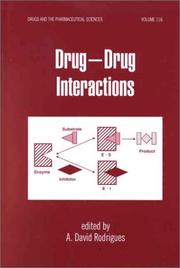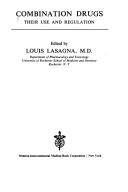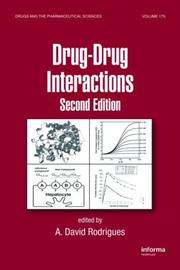| Listing 1 - 10 of 16 | << page >> |
Sort by
|

ISBN: 0824702832 9780824702830 Year: 2002 Publisher: New York : M. Dekker,
Abstract | Keywords | Export | Availability | Bookmark
 Loading...
Loading...Choose an application
- Reference Manager
- EndNote
- RefWorks (Direct export to RefWorks)
Drug Combinations. --- Drug interactions. --- Pharmacokinetics.

ISBN: 0913258237 Year: 1975 Publisher: New York : Stratton Intercontinental Medical Book Corp.,
Abstract | Keywords | Export | Availability | Bookmark
 Loading...
Loading...Choose an application
- Reference Manager
- EndNote
- RefWorks (Direct export to RefWorks)
Chemotherapy, Combination --- Drug Combinations --- Congresses --- Congresses.

ISBN: 9780849375934 0849375932 Year: 2008 Volume: 179 Publisher: New York: Informa healthcare,
Abstract | Keywords | Export | Availability | Bookmark
 Loading...
Loading...Choose an application
- Reference Manager
- EndNote
- RefWorks (Direct export to RefWorks)
Helping researchers predict drug interactions in a more accurate and effective manner, this text covers every critical aspect of metabolism-based drug-drug interactions, including preclinical, clinical, toxicological, regulatory, and marketing perspectives by leaders in their respective fields.
Drug interactions --- Pharmacokinetics --- Drug Interactions --- Pharmaceutical Preparations --- metabolism --- Drug Combinations. --- Drug interactions. --- Pharmacokinetics. --- Metabolism. --- Pharmaceutical Preparations - metabolism
Dissertation
Abstract | Keywords | Export | Availability | Bookmark
 Loading...
Loading...Choose an application
- Reference Manager
- EndNote
- RefWorks (Direct export to RefWorks)
Pharmaceutical Preparations --- Chronic Disease --- Health Services for the Aged --- Polypharmacy. --- Medical Overuse --- Drug Combinations --- administration & dosage. --- drug therapy. --- organization & administration. --- Theses --- Polymedication --- Polypharmacy --- administration & dosage --- drug therapy --- organization & administration
Book
Abstract | Keywords | Export | Availability | Bookmark
 Loading...
Loading...Choose an application
- Reference Manager
- EndNote
- RefWorks (Direct export to RefWorks)
Pathological dermatology --- Pharmacology. Therapy --- Drug Therapy, Combination. --- Skin Diseases --- Acne Vulgaris --- Hirsutism --- Androgen Antagonists --- Chemotherapy, Combination --- Combination Drug Therapy --- Drug Polytherapy --- Therapy, Combination Drug --- Combination Chemotherapy --- Polychemotherapy --- Chemotherapies, Combination --- Combination Chemotherapies --- Combination Drug Therapies --- Drug Polytherapies --- Drug Therapies, Combination --- Polychemotherapies --- Polytherapies, Drug --- Polytherapy, Drug --- Therapies, Combination Drug --- Drug Combinations --- Polypharmacy --- drug therapy. --- therapeutic use. --- Drug Therapy, Combination --- drug therapy --- therapeutic use --- Anti-androgenes --- Dermatologie --- Oestrogenes
Book
Year: 2021 Publisher: Basel, Switzerland MDPI - Multidisciplinary Digital Publishing Institute
Abstract | Keywords | Export | Availability | Bookmark
 Loading...
Loading...Choose an application
- Reference Manager
- EndNote
- RefWorks (Direct export to RefWorks)
Droplet microfluidics has dramatically developed in the past decade and has been established as a microfluidic technology that can translate into commercial products. Its rapid development and adoption have relied not only on an efficient stabilizing system (oil and surfactant), but also on a library of modules that can manipulate droplets at a high-throughput. Droplet microfluidics is a vibrant field that keeps evolving, with advances that span technology development and applications. Recent examples include innovative methods to generate droplets, to perform single-cell encapsulation, magnetic extraction, or sorting at an even higher throughput. The trend consists of improving parameters such as robustness, throughput, or ease of use. These developments rely on a firm understanding of the physics and chemistry involved in hydrodynamic flow at a small scale. Finally, droplet microfluidics has played a pivotal role in biological applications, such as single-cell genomics or high-throughput microbial screening, and chemical applications. This Special Issue will showcase all aspects of the exciting field of droplet microfluidics, including, but not limited to, technology development, applications, and open-source systems.
Technology: general issues --- FADS --- emulsification --- droplet coalescence --- enzyme engineering --- synthetic biology --- droplet formation --- phase field model --- interfacial tension --- glass capillary microfluidic device --- fluidic mixer --- air bubble --- 3D printing --- microcapsules --- double-emulsion drops --- osmotic pressure --- ultra-thin-shell --- microfluidics --- droplet array --- microvalve --- droplets --- lock-in detection --- real-time calibration --- homogeneous immunoassay --- on-chip mergers --- pneumatic valves --- programmable droplet formation --- dilutions --- Microfluidics --- drug combinations --- screening --- droplet microfluidics --- sorting --- passive sorting --- photo-tag --- n/a
Book
Year: 2021 Publisher: Basel, Switzerland MDPI - Multidisciplinary Digital Publishing Institute
Abstract | Keywords | Export | Availability | Bookmark
 Loading...
Loading...Choose an application
- Reference Manager
- EndNote
- RefWorks (Direct export to RefWorks)
Droplet microfluidics has dramatically developed in the past decade and has been established as a microfluidic technology that can translate into commercial products. Its rapid development and adoption have relied not only on an efficient stabilizing system (oil and surfactant), but also on a library of modules that can manipulate droplets at a high-throughput. Droplet microfluidics is a vibrant field that keeps evolving, with advances that span technology development and applications. Recent examples include innovative methods to generate droplets, to perform single-cell encapsulation, magnetic extraction, or sorting at an even higher throughput. The trend consists of improving parameters such as robustness, throughput, or ease of use. These developments rely on a firm understanding of the physics and chemistry involved in hydrodynamic flow at a small scale. Finally, droplet microfluidics has played a pivotal role in biological applications, such as single-cell genomics or high-throughput microbial screening, and chemical applications. This Special Issue will showcase all aspects of the exciting field of droplet microfluidics, including, but not limited to, technology development, applications, and open-source systems.
FADS --- emulsification --- droplet coalescence --- enzyme engineering --- synthetic biology --- droplet formation --- phase field model --- interfacial tension --- glass capillary microfluidic device --- fluidic mixer --- air bubble --- 3D printing --- microcapsules --- double-emulsion drops --- osmotic pressure --- ultra-thin-shell --- microfluidics --- droplet array --- microvalve --- droplets --- lock-in detection --- real-time calibration --- homogeneous immunoassay --- on-chip mergers --- pneumatic valves --- programmable droplet formation --- dilutions --- Microfluidics --- drug combinations --- screening --- droplet microfluidics --- sorting --- passive sorting --- photo-tag --- n/a
Book
Year: 2021 Publisher: Basel, Switzerland MDPI - Multidisciplinary Digital Publishing Institute
Abstract | Keywords | Export | Availability | Bookmark
 Loading...
Loading...Choose an application
- Reference Manager
- EndNote
- RefWorks (Direct export to RefWorks)
Droplet microfluidics has dramatically developed in the past decade and has been established as a microfluidic technology that can translate into commercial products. Its rapid development and adoption have relied not only on an efficient stabilizing system (oil and surfactant), but also on a library of modules that can manipulate droplets at a high-throughput. Droplet microfluidics is a vibrant field that keeps evolving, with advances that span technology development and applications. Recent examples include innovative methods to generate droplets, to perform single-cell encapsulation, magnetic extraction, or sorting at an even higher throughput. The trend consists of improving parameters such as robustness, throughput, or ease of use. These developments rely on a firm understanding of the physics and chemistry involved in hydrodynamic flow at a small scale. Finally, droplet microfluidics has played a pivotal role in biological applications, such as single-cell genomics or high-throughput microbial screening, and chemical applications. This Special Issue will showcase all aspects of the exciting field of droplet microfluidics, including, but not limited to, technology development, applications, and open-source systems.
Technology: general issues --- FADS --- emulsification --- droplet coalescence --- enzyme engineering --- synthetic biology --- droplet formation --- phase field model --- interfacial tension --- glass capillary microfluidic device --- fluidic mixer --- air bubble --- 3D printing --- microcapsules --- double-emulsion drops --- osmotic pressure --- ultra-thin-shell --- microfluidics --- droplet array --- microvalve --- droplets --- lock-in detection --- real-time calibration --- homogeneous immunoassay --- on-chip mergers --- pneumatic valves --- programmable droplet formation --- dilutions --- Microfluidics --- drug combinations --- screening --- droplet microfluidics --- sorting --- passive sorting --- photo-tag
Multi
Abstract | Keywords | Export | Availability | Bookmark
 Loading...
Loading...Choose an application
- Reference Manager
- EndNote
- RefWorks (Direct export to RefWorks)
Family Practice --- Aged. --- Polypharmacy. --- Drug-Related Side Effects and Adverse Reactions. --- Comorbidity. --- Multimorbidity --- Comorbidities --- Multimorbidities --- Medical Overuse --- Drug Combinations --- Elderly --- Geriatrics --- Longevity --- statistics & numerical data. --- Theses --- Adverse Drug Event --- Adverse Drug Reaction --- Drug Side Effects --- Drug Toxicity --- Side Effects of Drugs --- Toxicity, Drug --- Adverse Drug Events --- Adverse Drug Reactions --- Drug Event, Adverse --- Drug Events, Adverse --- Drug Reaction, Adverse --- Drug Reactions, Adverse --- Drug Related Side Effects and Adverse Reactions --- Drug Side Effect --- Drug Toxicities --- Effects, Drug Side --- Reactions, Adverse Drug --- Side Effect, Drug --- Side Effects, Drug --- Toxicities, Drug --- Drug Therapy --- Pharmaceutical Preparations --- Contraindications, Drug --- Drug Interactions --- Clinical Trials, Phase IV as Topic --- Polymedication --- adverse effects --- toxicity --- Aged --- Polypharmacy --- Drug-Related Side Effects and Adverse Reactions --- Comorbidity --- statistics & numerical data
Book
ISBN: 1461454557 1489997008 1461454565 1283934132 Year: 2013 Publisher: New York : Humana Press,
Abstract | Keywords | Export | Availability | Bookmark
 Loading...
Loading...Choose an application
- Reference Manager
- EndNote
- RefWorks (Direct export to RefWorks)
The concept of delivering ‘magic bullets’ to treat diseases was first proposed by Paul Erlich in the early 1900’s. The realization of this concept for the treatment of cancer occurred in the late 1990’s with the approval of monoclonal antibody therapies. The use of monoclonal antibodies conjugated (linked) to potent cytotoxic agents (antibody-drug conjugates, ADCs) for specifically delivering cytotoxics to cancer cells was an obvious extension of antibody-based therapy. ADCs have been under intense investigation for several decades; progress, however, has been limited due to toxicity or lack of improved efficacy compared to unconjugated cytotoxics. More recently, linker technology and target selection have advanced such that several ADCs and immunotoxins are undergoing clinical testing or are approved for use. This important volume gives the latest and most comprehensive information on the topic, describing different types of ADCs and immunotoxins for both hematologic and solid malignancies. Finally, the volume highlights the promise that this technology holds for diverse types of human cancer.
Antibodies. --- Antibody-drug conjugates. --- Immunotoxins -- Therapeutic use. --- Antibody-drug conjugates --- Antibody-toxin conjugates --- Diseases --- Pharmaceutical Preparations --- Immunoconjugates --- Immunoglobulins --- Therapeutics --- Analytical, Diagnostic and Therapeutic Techniques and Equipment --- Immunoproteins --- Chemicals and Drugs --- Blood Proteins --- Proteins --- Amino Acids, Peptides, and Proteins --- Immunotoxins --- Neoplasms --- Drug Therapy --- Antibodies --- Drug Combinations --- Medicine --- Health & Biological Sciences --- Oncology --- Antibody-toxin conjugates. --- Conjugates, Antibody-toxin --- Immunoglobulin-toxin conjugates --- Toxin-antibody conjugates --- Toxin-immunoglobulin conjugates --- Conjugates, Antibody-drug --- Drug-antibody conjugates --- Drug immunoconjugates --- Drug-immunoglobulin conjugates --- Immunoconjugates, Drug --- Immunoglobulin-drug conjugates --- Medicine. --- Cancer research. --- Biomedicine. --- Cancer Research. --- Biomedicine general. --- Immune globulins --- Immune serum globulin --- Blood proteins --- Globulins --- Plasma cells --- Antibody diversity --- Antigens --- Bacterial immunoglobulin-binding proteins --- Cancer research --- Clinical sciences --- Medical profession --- Human biology --- Life sciences --- Medical sciences --- Pathology --- Physicians --- Bioconjugates --- Immunopharmacology --- Immunotoxicology --- Toxins --- Drugs --- Dosage forms --- Oncology. --- Monoclonal antibodies. --- Antibodies, Monoclonal --- Monoclonal immunoglobulins --- Molecular cloning --- Tumors --- Health Workforce --- Biomedicine, general.
| Listing 1 - 10 of 16 | << page >> |
Sort by
|

 Search
Search Feedback
Feedback About UniCat
About UniCat  Help
Help News
News